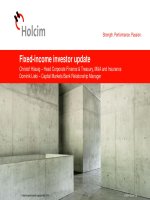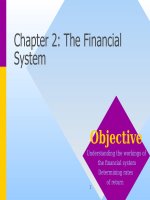Corporate finance chapter 015 option and contingent claims
Bạn đang xem bản rút gọn của tài liệu. Xem và tải ngay bản đầy đủ của tài liệu tại đây (471.54 KB, 52 trang )
Chapter 15: Options &
Contingent Claims
Objective
•To show how the law of one price may
be used to derive prices of options
•To show how to infer implied
volatility from option
1
prices
Copyright © Prentice Hall Inc. 2000. Author: Nick Bagley, bdellaSoft, Inc.
Chapter 15 Contents
15.1 How Options Work
15.7 The Black-Scholes Model
15.2 Investing with Options
15.8 Implied Volatility
15.3 The Put-Call Parity
Relationship
15.9 Contingent Claims Analysis of
Corporate Debt and Equity
15.4 Volatility & Option Prices
15.10 Credit Guarantees
15.5 Two-State Option Pricing
15.11 Other Applications of
Option-Pricing Methodology
15.6 Dynamic Replication & the
Binomial Model
2
Objectives
•
To show how the Law of One Price can be used to derive prices of
options
•
To show how to infer implied volatility form option prices
3
Table 15.1 List of IBM Option Prices
(Source: Wall Street Journal Interactive Edition, May 29, 1998)
IBM (IBM)
Strike
115
115
115
120
120
120
125
125
125
Underlying stock price 120 1/16
Call .
Put .
Expiration Volume
Jun
Oct
Jan
Jun
Oct
Jan
Jun
Oct
Jan
Last
1372
…
…
7
…
…
2377
121
91
1564
91
87
3 1/2
9 5/16
12 1/2
1 1/2
7 1/2
10 1/2
Open
Interest
4483
2584
15
8049
2561
8842
9764
2360
124
4
Volume
Last
756
10
53
873
45
…
1 3/16
5
6 3/4
2 7/8
7 1/8
…
17
…
…
5 3/4
…
…
Open
Interest
9692
967
40
9849
1993
5259
5900
731
70
Table 15.2 List of Index Option Prices
(Source: Wall Street Journal Interactive Edition, June 6, 1998)
S & P 500 INDEX -AM
Underlying
S&P500
(SPX)
Jun
Jun
Jul
Jul
Jun
Jun
Jul
Jul
High
Low
1113.88
1084.28
Strike
1110 call
1110 put
1110 call
1110 put
1120 call
1120 put
1120 call
1120 put
Chicago Exchange
Close
1113.86
Net
Change
19.03
Volume
2,081
1,077
1,278
152
80
211
67
10
Last
17 1/4
10
33 1/2
23 3/8
12
17
27 1/4
27 1/2
5
From
31-Dec
143.43
Net
Change
8 1/2
-11
9 1/2
-12 1/8
7
-11
8 1/4
-11
%
Change
14.8
Open
Interest
15,754
17,104
3,712
1,040
16,585
9,947
5,546
4,033
Terninal or Boundary Conditions for Call and Put Options
120
100
Dollars
80
Call
Put
60
40
20
0
0
20
40
60
80
100
120
140
-20
Underlying Price
6
160
180
200
Terminal Conditions of a Call and a Put Option with Strike = 100
Strike
100
Share
0
10
20
30
40
50
60
70
80
90
100
110
120
130
140
150
160
170
180
190
200
Call
0
0
0
0
0
0
0
0
0
0
0
10
20
30
40
50
60
70
80
90
100
Put
Share_Put
100
100
90
100
80
100
70
100
60
100
50
100
40
100
30
100
20
100
10
100
0
100
0
110
0
120
0
130
0
140
0
150
0
160
0
170
0
180
0
190
0
200
Bond Call_Bond
100
100
100
100
100
100
100
100
100
100
100
100
100
100
100
100
100
100
100
100
100
100
100
110
100
120
100
130
100
140
100
150
100
160
100
170
100
180
100
190
100
200
7
Stock, Call, Put, Bond
200
Call
Put
160
Share_Put
140
Bond
Stock, Call, Put, Bond, Put+Stock,
Call+Bond
180
Call_Bond
120
Share
100
80
60
40
20
0
0
20
40
60
80
100
120
140
Stock Price
8
160
180
200
Put-Call Parity Equation
Call ( Strike, Maturity ) +
Strike
= Put ( Strike, Maturity ) + Share
Maturity
(1 + rf )
9
Synthetic Securities
•
The put-call parity relationship may be solved for any of the four
security variables to create synthetic securities:
C=S+P-B
S=C-P+B
P=C-S+B
B=S+P-C
10
Options and Forwards
•
We saw in the last chapter that the discounted value of the forward
was equal to the current spot
•
The relationship becomes
Call ( Strike, Maturity ) +
Strike
Forward
=
Put
(
Strike
,
Maturity
)
+
(1 + rf ) Maturity
(1 + rf ) Maturity
11
Implications for European
Options
•
If (F > E) then (C > P)
•
If (F = E) then (C = P)
•
If (F < E) then (C < P)
• E is the common strike price
• F is the forward price of underlying share
• C is the call price
• P is the put price
12
Call and Put as a Function of Forward
Call = Put
16
call
put
asy_call_1
asy_put_1
14
Put, Call Values
12
10
8
6
4
2
0
90
92
94
96
98
100
102
104
106
108
Forward
Strike = Forward
13
110
Put and Call as Function of Share Price
60
call
Put and Call Prices
50
put
asy_call_1
40
asy_call_2
asy_put_1
30
asy_put_2
20
10
0
50
60
70
80
90
100
110
-10
Share Price
14
120
130
140
150
Put and Call as Function of Share Price
20
call
Put and Call Prices
put
asy_call_1
15
asy_call_2
asy_put_1
asy_put_2
10
5
0
80
85
90
95
100
105
110
115
Share Price
PV
Strike
15
Strik
e
120
Volatility and Option Prices, P0 = $100, Strike = $100
Stock Price Call Payoff Put Payoff
Low Volatility Case
Rise
Fall
Expectation
120
80
100
20
0
10
0
20
10
140
60
100
40
0
20
0
40
20
High Volatility Case
Rise
Fall
Expectation
16
Binary Model: Call
•
Implementation:
– the synthetic call, C, is created by
• buying a fraction x of shares, of the stock, S,
and simultaneously selling short risk free
bonds with a market value y
• the fraction x is called the hedge ratio
C = xS − y
17
Binary Model: Call
•
Specification:
– We have an equation, and given the value of
the terminal share price, we know the
terminal option value for two cases:
20 = x120 − y
0 = x80 − y
– By inspection, the solution is x=1/2, y = 40
18
Binary Model: Call
•
Solution:
– We now substitute the value of the
parameters x=1/2, y = 40 into the equation
C = xS − y
– to obtain:
1
C = 100 − 40 = $10
2
19
Binary Model: Put
•
Implementation:
– the synthetic put, P, is created by
• sell short a fraction x of shares, of the stock,
S, and simultaneously buy risk free bonds
with a market value y
• the fraction x is called the hedge ratio
P = − xS + y
20
Binary Model: Put
•
Specification:
– We have an equation, and given the value of
the terminal share price, we know the
terminal option value for two cases:
20 = x120 − y
0 = x80 − y
– By inspection, the solution is x=1/2, y = 60
21
Binary Model: Put
•
Solution:
– We now substitute the value of the
parameters x=1/2, y = 60 into the equation
P = − xS + y
– to obtain:
1
P = − 100 + 60 = $10
2
22
Decision Tree for Dynamic
Replication of a Call Option
<---------0 Months----------> <------------------6 Months----------------> 12 Months
StockPrice
x
y
CallPrice
x
y
CallPrice
$120.00
$110.00
$100.00
$90.00
$80.00
$20.00
$10.00
50.00%
100.00%
-$100.00
-$45.00
$0.00
$0.00
0.00%
$0.00
$0.00
($120*100%) + (-$100) = $20
23
The Black-Scholes Model:
Notation
• C = price of call
• N(.) = cum. norm. dist’n
• P = price of put
• The following are annual,
compounded continuously:
• S = price of stock
• E = exercise price
• T = time to maturity
• r = domestic risk free
rate of interest
• ln(.) = natural logarithm
• d = foreign risk free rate
or constant dividend yield
• e = 2.71828...
• σ = volatility
24
The Black-Scholes Model:
Equations
1 2
S
ln + r − d + σ T
E
2
d1 =
σ T
1 2
S
ln + r − d − σ T
E
2
d2 =
= d1 − σ T
σ T
C = Se − dT N ( d1 ) − Ee − rT N ( d 2 )
P = − Se − dT N ( − d1 ) + Ee − rT N ( − d 2 )
25









